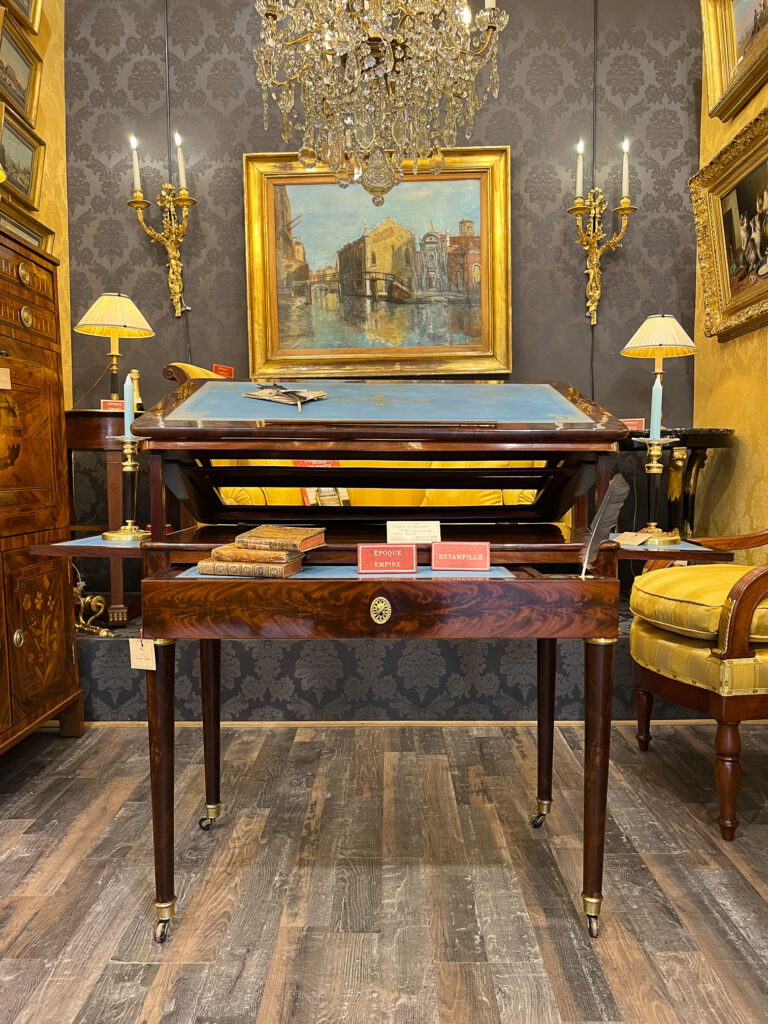François Honoré Jacob (1770-1841) – Table à la Tronchin en acajou d’époque Empire vers 1810
Table d’architecte de commande ou table à la Tronchin en placage d’acajou et placage d’acajou de Cuba flammé, ouvrant par un tiroir en ceinture découvrant une écritoire coulissante ainsi qu’un encrier et un plumier d’origine . Deux tirettes latérales, plateau mobile à crémaillère garni d’un superbe cuir bleu clair à décor à la feuille d’or, pieds fuselés terminés par des sabots et des roulettes en bronze doré.
Very fine French Empire period work stamped Jacob D Rue Meslée for François Honoré Jacob (1170-1841) and Château mark.
Dimensions : Hauteur 78 cm -Longueur 90 cm – Profondeur 52 cm – Longueur tirettes ouvertes 134 cm.
In very good condition, varnished in our workshops.
Biography:
François-Honoré-Georges Jacob-Desmalter (1770-1841) was the most successful Parisian cabinetmaker between 1796 and 1825.
Fils de Georges Jacob qui a lancé le style Louis XVI et le style Directoire, il s’associe en 1796 avec son frère Georges Jacob Fils pour créer Jacob Frères Rue Meslée. Son père avait bénéficié des commandes de la famille royale sous l’Ancien Régime, les deux frères satisfont les commandes de la famille impériale.
Faisant appel aux esquisses du peintre Jacques-Louis David et des ornemanistes Percier et Fontaine, les frères créent un mobilier s’inspirant de l’antiquité gréco-romaine pour lancer le style Empire.
Leur style se caractérise par une grande qualité du dessin, des lignes épurées, des formes originales, l’emploi de bronzes dorés ciselés (réalisés par Pierre-Philippe Thomire). En menuiserie, il emploie l’acajou, le bois doré et le bois laqué avec, parfois, des incrustations d’ébène et des bois indigènes tels que l’érable ou l’if.
Pour l’impératrice Joséphine, ils livrent des meubles au château de Malmaison, également au Palais Rohan de Strasbourg, entre 1807 et 1809, pour la chambre à coucher dite « de Napoléon Ier ». Ils travaillent au Château de Compiègne. Ils livrent l’imposant berceau du Roi de Rome, le précieux cabinet à bijoux de l’impératrice Marie-Louise, d’après les dessins de Percier et Fontaine. On leur doit le salon d’argent, au palais de l’Élysée.
Très dépendant des commandes impériales, leur atelier qui emploie plus de trois cents ouvriers, fait faillite en 1813 quand les finances du Premier Empire ne permettent plus d’honorer ses dettes. Jacob-Desmalter, parvient cependant à ressusciter son entreprise et, à la chute de l’Empire, il retrouve la clientèle paternelle des Bourbons pour réaliser le mobilier en style Restauration. Son fils, Georges Alphonse (1799-1870), lui succède en 1825.
He is buried in the Père-Lachaise cemetery.
The Tronchin table:
La table à la Tronchin est une table de la fin du XVIIIème siècle, apparue sous le règne de Louis XVI. Elle tire son nom d’un médecin genevois Théodore Tronchin (1709-1781) qui publie à l’époque des travaux sur les maladies osseuses liées à la mauvaise position que l’on adopte à sa table de travail et sur les avantages qu’il y aurait à créer une table à pupitre inclinable qui permettrait de garder le dos bien droit et d’éviter ainsi toute déformation ou douleur, que l’on travaille assis ou debout. L’innovation de cette table du XVIIIème siècle vient d’un mécanisme dissimulé dans l’épaisseur de la ceinture et qui permet d’élever le plateau à la hauteur désirée.
Ainsi, le plateau de cette table qui pouvait être plein ou muni d’un pupitre gainé de cuir, est inclinable à l’angle voulu grâce à un pupitre à crans, et réhaussable grâce à un jeux de deux ou quatre crémaillères dissimulées à l’intérieur des pieds.




